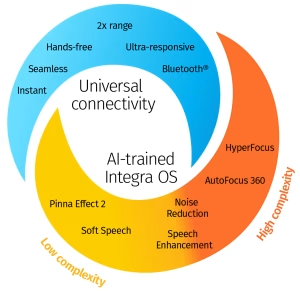

What is the hearing handicap assessment, and how does it compare to pure tone testing?
The hearing losses inherent to the natural process of aging represent a major public health issue. The audiogram is still considered the gold standard, which includes pure tone audiometry (PTA), bone conduction thresholds, and speech testing. The audiogram is the main hearing test used to identify the hearing threshold levels of a person. Enabling the determination of the diagnosis of the degree, type, and configuration of a hearing loss.
If you have not had a hearing test done by an audiologist, perhaps you remember being tested in school or at the doctor’s office. You might remember putting on earphones and raising your hand when you heard the “beep”. This is the “pure tone” part of the testing. Pure tone testing is also called air conduction testing since the sounds go through your outer and middle ear. This test helps find the quietest sound you can hear at different frequencies.
Hearing impairment refers to any restriction or lack of ability to perceive sound and to perform tasks. Hearing loss is considered to have thresholds across a range of frequencies below 20 or 25 dB HL. Interestingly, many people who have hearing thresholds within normal limits also have some trouble hearing. Just because you may or may not have a hearing loss, it may or may not mean you have difficulty hearing in various environments. A great solution to figure out if you need help is to determine it via an interview. This helps us see if you do struggle to hear and to what degree and in which environments. These types of tests are called hearing handicap assessments. There are many tests that a human can take.
Because this is an online store it isn’t easy to do a hearing test on our visitors unless you do one online. However, we don’t think that test gives us enough information about our visitors. So we have evaluated this assessment to help.
Hearing handicap refers to the emotional and social aspects resulting from hearing impairment. This can sometimes restrict the person’s participation in everyday activities, as well as impact family relationships and social interactions.
In 1982, Ventry and Weinstein developed the Hearing Handicap Inventory for the Elderly (HHIE). A self-assessment tool of 25 questions aimed to assess the impact of hearing loss.
In 1983, the authors published a reduced version containing only 10 questions. These questions were divided between social and emotional aspects. The Hearing Handicap Inventory for the Elderly-Screening version (HHIE-S), proposed as a screening tool to detect the degree of hearing complaints.
We reviewed this study to assess the accuracy of the HHIE-S to diagnosis hearing loss in the elderly compared to pure-tone tests.
Investigated by: Alexandre Barbosa Servidoni and Lucieni de Oliveira Conterno. Published in International Archives of Otorhinolaryngology Published online Mar 31, 2017
A group of patients in Brazil was the subject of the study. The study participants were over the age of 60, were not already in the process of audiological rehabilitation, and had no active infectious diseases or tumors. The study was made up of 138 patients. The HHIE-S questionnaire was given by the same researcher, with each item read orally and immediately answered by the participant. After the questionnaire, the individual was then referred for further examination, including pure tone audiometry testing. (Done by a speech pathologist and most often on the same day as the questionnaire).
The HHIE-S showed that 33 (23.9%) had no perception of hearing handicap, 65 (47.1%) had mild/moderate perception of handicap, and 40 (29%) had a significant perception of handicap. So the prevalence of hearing impairment by the HHIE-S questionnaire was 105/138 (76.1%)!
The PTA evaluation of these patients showed normal hearing in 28 (20.3%); mild hearing loss in 39 (28.3%); moderate loss in 53 (38.4%); severe loss in 13 (9.4%), and profound hearing loss in 5 (3.6%). The prevalence of hearing impairment was 110/138 (79.7%).
Evaluating the results of this study, the authors noticed a greater agreement on the extremes. That is, between persons with normal hearing and absent handicaps and between those with profound hearing loss and severe handicaps. The data seems to suggest that the HHIE-S is more suitable for identifying more disabling hearing losses. It appears that pure tone testing alone is not sufficient to describe the reaction of the person before a hearing disorder. It does not detect the hearing handicap. Yet, the HHIE-S alone is not always able to accurately detect auditory sensitivity.
The study authors conclude that the HHIE-S questionnaire is suitable in the screening for hearing loss in the elderly. Given its high accuracy and user-friendly format. Moreover, it is a simple and inexpensive tool, requiring little time for its application. It must be kept in mind that no patient should be in a process of rehabilitation without both instruments, the PTA and the HHIE-S, complementing each other.
Because of these results and the nature in which we want to provide accessible, affordable, and helpful solutions, we are going to be implementing the short-form screening tool of the Hearing Handicap Assessment. But please don’t be surprised if we also request a copy of your audiogram or your pure tone scores.
This questionnaire could help you convince a loved one that their hearing loss is causing problems, or if you are considering seeking help, it could help you quantify how your possible hearing loss is impacting your life. Perhaps having an idea of your hearing handicap before the hearing test will help you come to terms with a possible plan of action or solution to take care of your needs before your first appointment. Being aware is the first step in getting some help. Sometimes that first diagnosis is a shock, even if you suspect it before coming to the appointment. Those in hearing health care want the process to be as smooth and painless as possible for all our patients. Happy Hearing!
Karen (edited by Kim)
ReSound Savi RIE hearing aids offer cutting-edge AI-powered technology to enhance speech clarity and reduce background noise. Designed for all-day comfort, these rechargeable hearing aids provide seamless connectivity and superior sound processing. Key features include:
ELEHEAR Beyond OTC hearing aids utilize AI-powered technology to enhance speech clarity and reduce background noise. Designed for individuals with mild to moderate hearing loss, these hearing aids provide a customizable and comfortable listening experience for daily use. Key features include:
Powered By SinglerDesign.com